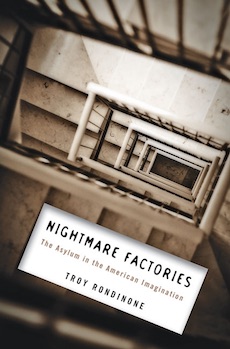By Louis J. Kern
The asylum, Michel Foucault observed, is an institution of “endless trial,” furnished with “police, magistrates, and torturers . . . whereby any transgression in life . . . becomes a social crime.” It is not a “free realm of observation, diagnosis, and therapeutics,” but a “juridical space where one is accused, judged, and condemned”. . . .“Madness will be punished in the asylum, even if it is innocent outside of it” (Madness and Civilization: A History of Insanity in the Age of Reason, 1965). Rondinone’s lively survey of popular perceptions of mental institutions and their abuses in mass entertainment (B-films, exploitative biographies, and popular literature) more than confirms Foucault’s structural critique.
Beginning with Edgar Allan Poe’s “The System of Dr.Tarr and Prof. Fether” (1845), in which the lunatics have taken over the asylum, and Wilkie Collins’ The Woman in White (1860), where a falsely institutionalized woman escapes bearing dangerous knowledge, Rondinone establishes central motifs in the paranoiac critique of the asylum: the conviction that it is psychiatric treatment that is itself sadistic insanity conducted by madmen, and that imperiled innocents are “railroaded” into confinement by nefarious villains abetted by legal and medical authorities. We repeatedly confront the horrors of straitjackets, hydro-therapy, ECT (electroconvulsive therapy) insulin and experimental drug therapy, and lobotomy, experiential evidence of which is revealed in the Bellevue exposé of Nelly Bly (1887) and Frederick Wiseman’s Titicut Follies (1968) as well as experiential accounts of Elizabeth Packard (The Prisoner’s Hidden Life; or, Insane Asylums Unveiled, 1868 ), Sylvia Plath’s The Bell Jar (1963), and Frances Farmer’s Will There Really Be a Morning (1972). Cinematically, the crazed doctor/superintendent received classic treatment in Robert Wiene’s The Cabinet of Dr. Caligari (1920) and The Monster (1925), evoking terrors of Dracula and Frankenstein, while the obverse, escaped serial killer patients were enduringly presented in the Nightmare on Elm Street (1984-89) and the Halloween series (1978-2007), that neatly coincided with the social policy of deinstitutionalization, rendering the whole world the asylum. The intense, internalized paranoia and horror of institutionalization were graphicly depicted in The Snake Pit (1948) and One Flew Over the Cuckoo’s Nest (1975).
Rondinone reveals the connections between mass media vehicles and the social, emotional, and political concerns of an era. For Poe, guilt about slavery and fear of servile insurrection was expressed literarily; works of the 1920s and 30s (the Freudian era) reflected fear of severe regimentation and intense, intrusive monitoring; the 1950s Beat quest for personal liberation decried the insanity of the Cold War, finding the sane inside the asylum, and that vision of universal insanity prevailed post-1980, when deinstitutionalization distributed former inmates throughout the community. From the outset, a gothic, noirist sensibility of the asylum prevailed.
Despite variations in therapeutics and patient demographics, popular perception has found the asylum one continuous nightmare. By the late twentieth century, deindustrialization, offshore manufacturing, extreme inequities in wealth, terrorism threats, and the hollowing out of welfare insured that the asylum would remain a potent gothic synecdoche. Paraphrasing Ken Kesey, Rondinone concludes that in confronting the disruptions and threatening challenges of our world, “what we cannot overcome, we transmute into metaphor.”
While Rondinone’s concern is exclusively with the imaginative response to the asylum as a total institution, there were very real, clandestine Frankensteinian LSD experiments of mind control conducted by Sidney Gottlieb in the worldwide CIA brainwashing program MKULTRA (1963-73). The vulnerable population—prisoners, drug addicts, minorities, the homeless—were targeted, and some were “railroaded” into asylums. See John Marks, The Search for the Manchurian Candidate: The CIA and Mind Control (1979). The world of 1984 had fully realized Foucault’s nightmare asylum.
Louis J. Kern (ΦBK, Clark University) is professor emeritus of history at Hofstra University. Hofstra University is home to the Omega of New York chapter of Phi Beta Kappa.




